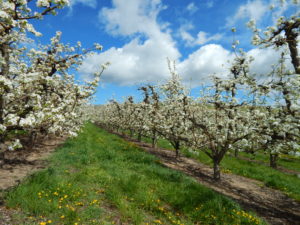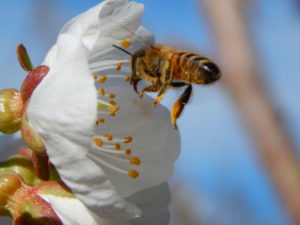Spring has sprung! Sort of. We know many parts of the U.S. are still experiencing winter weather, but here in the Pacific Northwest, we are gearing up for one of our favorite times of the year…. bloom! The birds are chirping. The bees are buzzing. Soon, fruit trees around the state of Washington will be covered in pink and white blossoms.
 In no time at all, Washington cherries, apricots, peaches and nectarines will be available at your local grocery store! Then, not too far behind them, you’ll start seeing new crop apples and pears.
In no time at all, Washington cherries, apricots, peaches and nectarines will be available at your local grocery store! Then, not too far behind them, you’ll start seeing new crop apples and pears.
So, how long does it take from bloom to harvest? Harvest timing is not the same for all tree fruit; it varies based on 1) the type of fruit and 2) the variety of fruit. For cherries, it can be anywhere from 55 days to 90 days depending on the variety.
Bloom
Bloom varies from year to year; weather has a large hand in when it will occur. The earliest full bloom date recorded was April 9th, in both 2015 & 2016. In 2017, the full bloom date was May 1st (for apples). Full bloom is defined as the day 60% of “king blossoms” are open on the north side of the tree (WSU Tree Fruit).
Daily high temperatures are used to predict bloom based on degree days (DD) above 43℉.
Using Red Delicious as the baseline for apples:
The Average Full Bloom Date From 1995-2005 is: April 23
The Average Full Bloom Date From 1990-1999 is: April 21
 Red Delicious happens to be a relatively late blossoming apple cultivar. Other apple cultivars, on warmer sites in the local region, will bloom up to a week earlier. Elevation and slope aspect are quite variable over short distances in Eastern Washington (state), and very influential in relation to blossom development rate. Lower elevation orchards (~700 ft. elevation) may see blossoms up to a month before higher elevations (~3,400 ft.) (WSU Tree Fruit).
Red Delicious happens to be a relatively late blossoming apple cultivar. Other apple cultivars, on warmer sites in the local region, will bloom up to a week earlier. Elevation and slope aspect are quite variable over short distances in Eastern Washington (state), and very influential in relation to blossom development rate. Lower elevation orchards (~700 ft. elevation) may see blossoms up to a month before higher elevations (~3,400 ft.) (WSU Tree Fruit).
Apricots are the first tree fruit to bloom in Washington, which is typically 3 weeks prior to Red Delicious. Peaches and nectarines are next, and are about 14 – 17 before apples. Cherries follow peaches and nectarines, blooming roughly 10 – 14 days before apples. Then come pears, which are about 7 – 10 days prior to apples.
During bloom, pollination must occur in order for fruit to develop. Pollen is transferred primarily by honeybees. Honeybees work best when temperatures reach 65oF+.
Harvest
At Sage Fruit, our harvest begins with cherries in early-to-mid June and finishes in early November with the last of our apple varieties. Each orchard block is evaluated individually using various fruit maturity-testing methods. A general benchmark growers tend to use to estimate maturity date is “days after full bloom.” This is especially helpful if the grower has data from previous years. Depending on weather, the value may vary from 5-20 days year-to-year.
Maturity testing typically begins 2+ weeks in advance of the estimated harvest date, and continues each week until the fruit is picked from the tree. Firmness, soluble solids concentration (SSC) and starch content are the primary tests performed to determine how far a long the fruit is. Other considerations include: fruit size, taste and skin coloration.
For more on specific maturity testing click here. The Washington State University database is extremely helpful!
2017 Harvest Start Times:
| Cherries | ||
| Rainier | Early-to-Mid June | |
| Dark Sweet | Mid-June |
| Apricots | Mid-June |
| Peaches | Late July |
| Nectarines | Late July |
| Pears | ||
| Bartlett | Early-to-Mid August | |
| Anjou | Late August | |
| Bosc | Early September | |
| Red Anjou | Early September |
| Apples | ||
| Gala | Mid-August | |
| Honeycrisp | Late August | |
| Breeze | Late August | |
| Golden Delicous | Early September | |
| Granny Smith | Mid-September | |
| Fuji | Mid-September | |
| Jonagold | Mid-September | |
| Red Delicious | Late September | |
| Braeburn | Mid-October | |
| Pink Lady | Mid-to-Late October | |
| Cameo | Mid-to-Late October |